Lancia Musa 2010 Owner handbook (in English)
Manufacturer: LANCIA, Model Year: 2010, Model line: Musa, Model: Lancia Musa 2010Pages: 218, PDF Size: 3.71 MB
Page 181 of 218
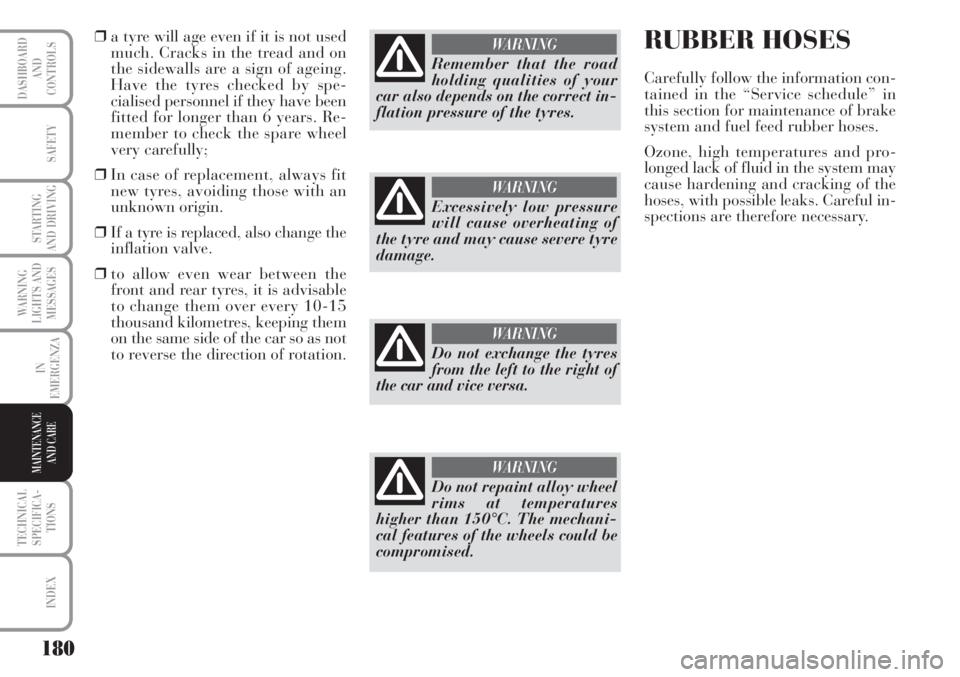
180
WARNING
LIGHTS AND
MESSAGES
TECHNICAL
SPECIFICA-
TIONS
INDEX
DASHBOARD
AND
CONTROLS
SAFETY
STARTING
AND DRIVING
IN
EMERGENZA
MAINTENANCE
AND CARE
❒a tyre will age even if it is not used
much. Cracks in the tread and on
the sidewalls are a sign of ageing.
Have the tyres checked by spe-
cialised personnel if they have been
fitted for longer than 6 years. Re-
member to check the spare wheel
very carefully;
❒In case of replacement, always fit
new tyres, avoiding those with an
unknown origin.
❒If a tyre is replaced, also change the
inflation valve.
❒to allow even wear between the
front and rear tyres, it is advisable
to change them over every 10-15
thousand kilometres, keeping them
on the same side of the car so as not
to reverse the direction of rotation.
Remember that the road
holding qualities of your
car also depends on the correct in-
flation pressure of the tyres.
WARNING
Excessively low pressure
will cause overheating of
the tyre and may cause severe tyre
damage.
WARNING
Do not exchange the tyres
from the left to the right of
the car and vice versa.
WARNING
Do not repaint alloy wheel
rims at temperatures
higher than 150°C. The mechani-
cal features of the wheels could be
compromised.
WARNING
RUBBER HOSES
Carefully follow the information con-
tained in the “Service schedule” in
this section for maintenance of brake
system and fuel feed rubber hoses.
Ozone, high temperatures and pro-
longed lack of fluid in the system may
cause hardening and cracking of the
hoses, with possible leaks. Careful in-
spections are therefore necessary.
Page 182 of 218
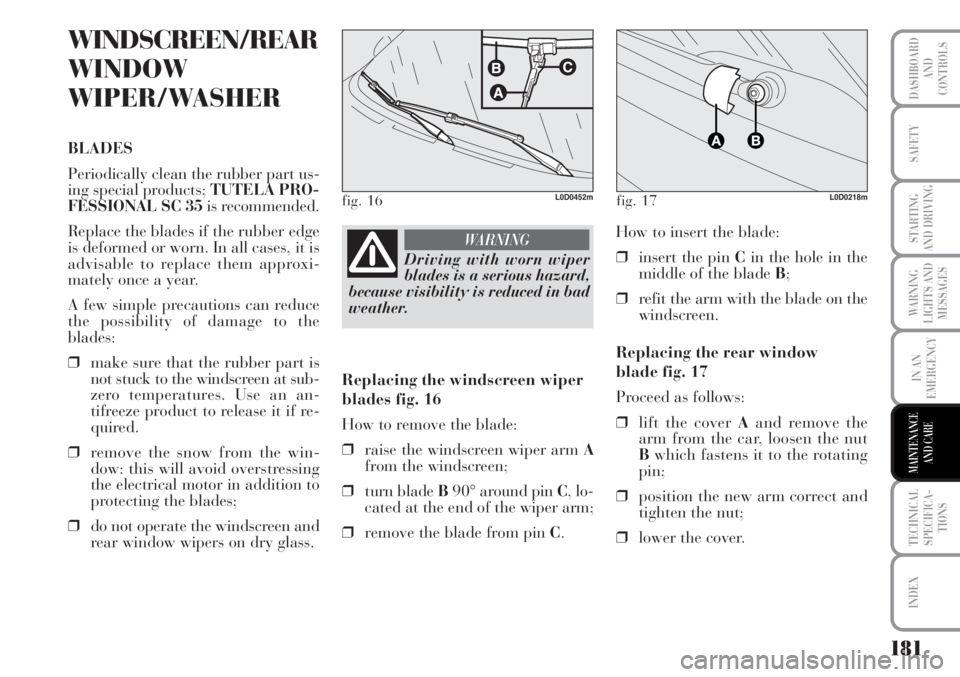
181
WARNING
LIGHTS AND
MESSAGES
TECHNICAL
SPECIFICA-
TIONS
INDEX
DASHBOARD
AND
CONTROLS
SAFETY
STARTING
AND DRIVING
IN AN
EMERGENCY
MAINTENANCE
AND CARE
WINDSCREEN/REAR
WINDOW
WIPER/WASHER
BLADES
Periodically clean the rubber part us-
ing special products; TUTELA PRO-
FESSIONAL SC 35is recommended.
Replace the blades if the rubber edge
is deformed or worn. In all cases, it is
advisable to replace them approxi-
mately once a year.
A few simple precautions can reduce
the possibility of damage to the
blades:
❒make sure that the rubber part is
not stuck to the windscreen at sub-
zero temperatures. Use an an-
tifreeze product to release it if re-
quired.
❒remove the snow from the win-
dow: this will avoid overstressing
the electrical motor in addition to
protecting the blades;
❒do not operate the windscreen and
rear window wipers on dry glass.
Driving with worn wiper
blades is a serious hazard,
because visibility is reduced in bad
weather.
WARNINGHow to insert the blade:
❒insert the pin Cin the hole in the
middle of the blade B;
❒refit the arm with the blade on the
windscreen.
Replacing the rear window
blade fig. 17
Proceed as follows:
❒lift the cover Aand remove the
arm from the car, loosen the nut
Bwhich fastens it to the rotating
pin;
❒position the new arm correct and
tighten the nut;
❒lower the cover.
fig. 16L0D0452mfig. 17L0D0218m
Replacing the windscreen wiper
blades fig. 16
How to remove the blade:
❒raise the windscreen wiper arm A
from the windscreen;
❒turn blade B90° around pin C, lo-
cated at the end of the wiper arm;
❒remove the blade from pin C.
Page 183 of 218
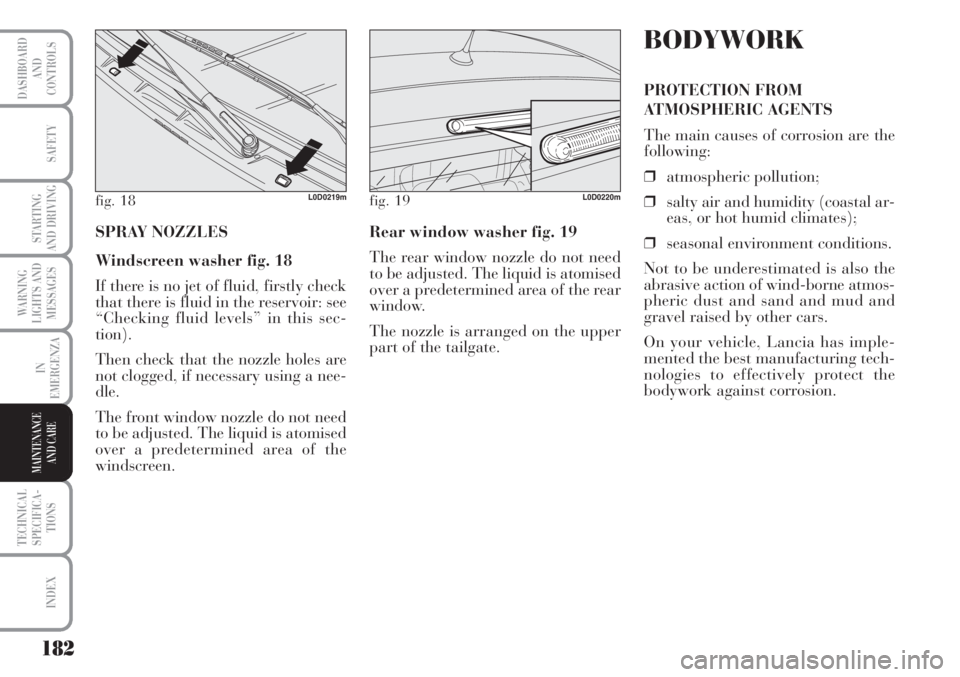
182
WARNING
LIGHTS AND
MESSAGES
TECHNICAL
SPECIFICA-
TIONS
INDEX
DASHBOARD
AND
CONTROLS
SAFETY
STARTING
AND DRIVING
IN
EMERGENZA
MAINTENANCE
AND CARE
SPRAY NOZZLES
Windscreen washer fig. 18
If there is no jet of fluid, firstly check
that there is fluid in the reservoir: see
“Checking fluid levels” in this sec-
tion).
Then check that the nozzle holes are
not clogged, if necessary using a nee-
dle.
The front window nozzle do not need
to be adjusted. The liquid is atomised
over a predetermined area of the
windscreen.Rear window washer fig. 19
The rear window nozzle do not need
to be adjusted. The liquid is atomised
over a predetermined area of the rear
window.
The nozzle is arranged on the upper
part of the tailgate.
BODYWORK
PROTECTION FROM
ATMOSPHERIC AGENTS
The main causes of corrosion are the
following:
❒atmospheric pollution;
❒salty air and humidity (coastal ar-
eas, or hot humid climates);
❒seasonal environment conditions.
Not to be underestimated is also the
abrasive action of wind-borne atmos-
pheric dust and sand and mud and
gravel raised by other cars.
On your vehicle, Lancia has imple-
mented the best manufacturing tech-
nologies to effectively protect the
bodywork against corrosion.
fig. 18L0D0219mfig. 19L0D0220m
Page 184 of 218

183
WARNING
LIGHTS AND
MESSAGES
TECHNICAL
SPECIFICA-
TIONS
INDEX
DASHBOARD
AND
CONTROLS
SAFETY
STARTING
AND DRIVING
IN AN
EMERGENCY
MAINTENANCE
AND CARE
These include:
❒painting products and systems
which give the car particular re-
sistance to corrosion and abrasion;
❒use of galvanised (or pretreated)
steel sheets, with high resistance
to corrosion;
❒spraying of plastic parts with a pro-
tective function in the more ex-
posed points: under door, inner
wing parts, edges, etc.;
❒boxed parts are designed to pre-
vent condensation and pooling of
water which can cause corrosion
from the inside.BODY AND UNDERBODY
WARRANTY
Your car is covered by warranty
against perforation due to rust of any
original element of the structure or
body. For the general terms of this
warranty, refer to Lancia Warranty
Booklet.ADVICE FOR PRESERVING THE
BODYWORK
Paint
Paintwork does not only serve an aes-
thetic purpose, but also protects the
underlying sheet metal.
Touch up abrasions and scratches im-
mediately to prevent the formation of
rust. Only use genuine spare paint
products for touch-ups (see “Body-
work paint identification plate” in the
“Technical Specifications” section).
Normal maintenance of paintwork
consists in washing the car: the fre-
quency depends on the conditions and
environment where the car is used.
For example, it is advisable to wash
the car more often in areas with a
high environmental pollution or on
roads sprinkled with salt.
Page 185 of 218
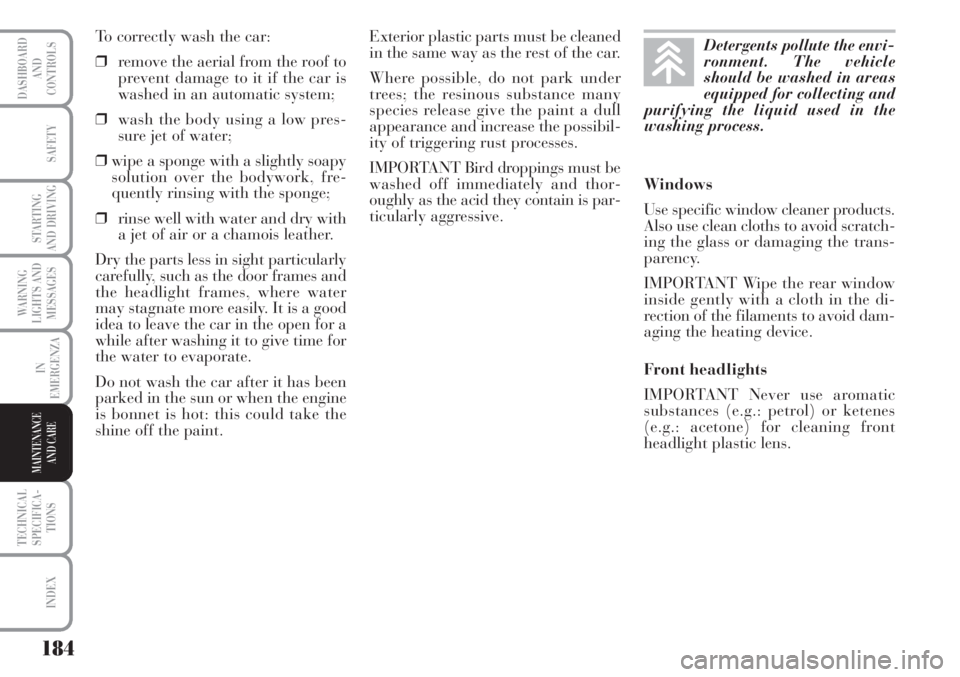
184
WARNING
LIGHTS AND
MESSAGES
TECHNICAL
SPECIFICA-
TIONS
INDEX
DASHBOARD
AND
CONTROLS
SAFETY
STARTING
AND DRIVING
IN
EMERGENZA
MAINTENANCE
AND CARE
To correctly wash the car:
❒remove the aerial from the roof to
prevent damage to it if the car is
washed in an automatic system;
❒wash the body using a low pres-
sure jet of water;
❒wipe a sponge with a slightly soapy
solution over the bodywork, fre-
quently rinsing with the sponge;
❒rinse well with water and dry with
a jet of air or a chamois leather.
Dry the parts less in sight particularly
carefully, such as the door frames and
the headlight frames, where water
may stagnate more easily. It is a good
idea to leave the car in the open for a
while after washing it to give time for
the water to evaporate.
Do not wash the car after it has been
parked in the sun or when the engine
is bonnet is hot: this could take the
shine off the paint.Exterior plastic parts must be cleaned
in the same way as the rest of the car.
Where possible, do not park under
trees; the resinous substance many
species release give the paint a dull
appearance and increase the possibil-
ity of triggering rust processes.
IMPORTANT Bird droppings must be
washed off immediately and thor-
oughly as the acid they contain is par-
ticularly aggressive.Windows
Use specific window cleaner products.
Also use clean cloths to avoid scratch-
ing the glass or damaging the trans-
parency.
IMPORTANT Wipe the rear window
inside gently with a cloth in the di-
rection of the filaments to avoid dam-
aging the heating device.
Front headlights
IMPORTANT Never use aromatic
substances (e.g.: petrol) or ketenes
(e.g.: acetone) for cleaning front
headlight plastic lens.Detergents pollute the envi-
ronment. The vehicle
should be washed in areas
equipped for collecting and
purifying the liquid used in the
washing process.
Page 186 of 218
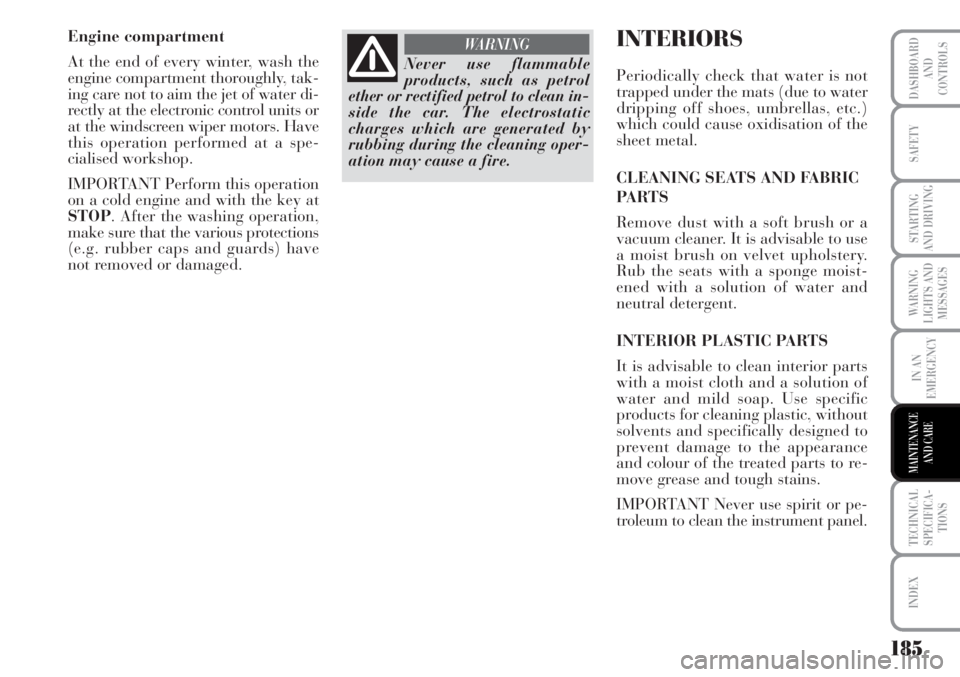
185
WARNING
LIGHTS AND
MESSAGES
TECHNICAL
SPECIFICA-
TIONS
INDEX
DASHBOARD
AND
CONTROLS
SAFETY
STARTING
AND DRIVING
IN AN
EMERGENCY
MAINTENANCE
AND CARE
Engine compartment
At the end of every winter, wash the
engine compartment thoroughly, tak-
ing care not to aim the jet of water di-
rectly at the electronic control units or
at the windscreen wiper motors. Have
this operation performed at a spe-
cialised workshop.
IMPORTANT Perform this operation
on a cold engine and with the key at
STOP. After the washing operation,
make sure that the various protections
(e.g. rubber caps and guards) have
not removed or damaged.
Never use flammable
products, such as petrol
ether or rectified petrol to clean in-
side the car. The electrostatic
charges which are generated by
rubbing during the cleaning oper-
ation may cause a fire.
WARNINGINTERIORS
Periodically check that water is not
trapped under the mats (due to water
dripping off shoes, umbrellas, etc.)
which could cause oxidisation of the
sheet metal.
CLEANING SEATS AND FABRIC
PA R T S
Remove dust with a soft brush or a
vacuum cleaner. It is advisable to use
a moist brush on velvet upholstery.
Rub the seats with a sponge moist-
ened with a solution of water and
neutral detergent.
INTERIOR PLASTIC PARTS
It is advisable to clean interior parts
with a moist cloth and a solution of
water and mild soap. Use specific
products for cleaning plastic, without
solvents and specifically designed to
prevent damage to the appearance
and colour of the treated parts to re-
move grease and tough stains.
IMPORTANT Never use spirit or pe-
troleum to clean the instrument panel.
Page 187 of 218
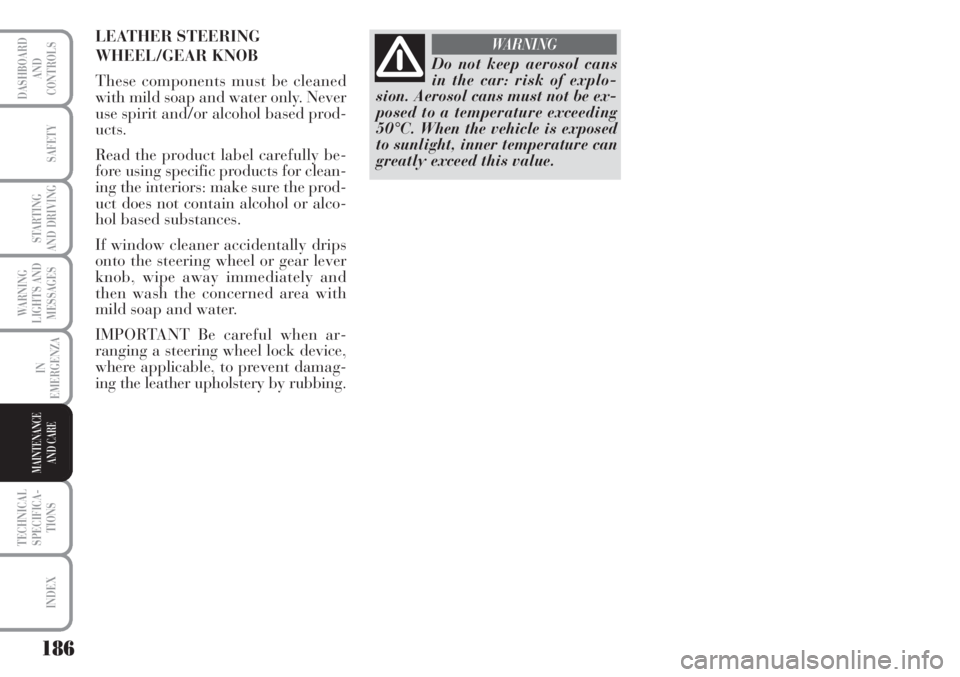
186
WARNING
LIGHTS AND
MESSAGES
TECHNICAL
SPECIFICA-
TIONS
INDEX
DASHBOARD
AND
CONTROLS
SAFETY
STARTING
AND DRIVING
IN
EMERGENZA
MAINTENANCE
AND CARE
Do not keep aerosol cans
in the car: risk of explo-
sion. Aerosol cans must not be ex-
posed to a temperature exceeding
50°C. When the vehicle is exposed
to sunlight, inner temperature can
greatly exceed this value.
WARNINGLEATHER STEERING
WHEEL/GEAR KNOB
These components must be cleaned
with mild soap and water only. Never
use spirit and/or alcohol based prod-
ucts.
Read the product label carefully be-
fore using specific products for clean-
ing the interiors: make sure the prod-
uct does not contain alcohol or alco-
hol based substances.
If window cleaner accidentally drips
onto the steering wheel or gear lever
knob, wipe away immediately and
then wash the concerned area with
mild soap and water.
IMPORTANT Be careful when ar-
ranging a steering wheel lock device,
where applicable, to prevent damag-
ing the leather upholstery by rubbing.
Page 188 of 218
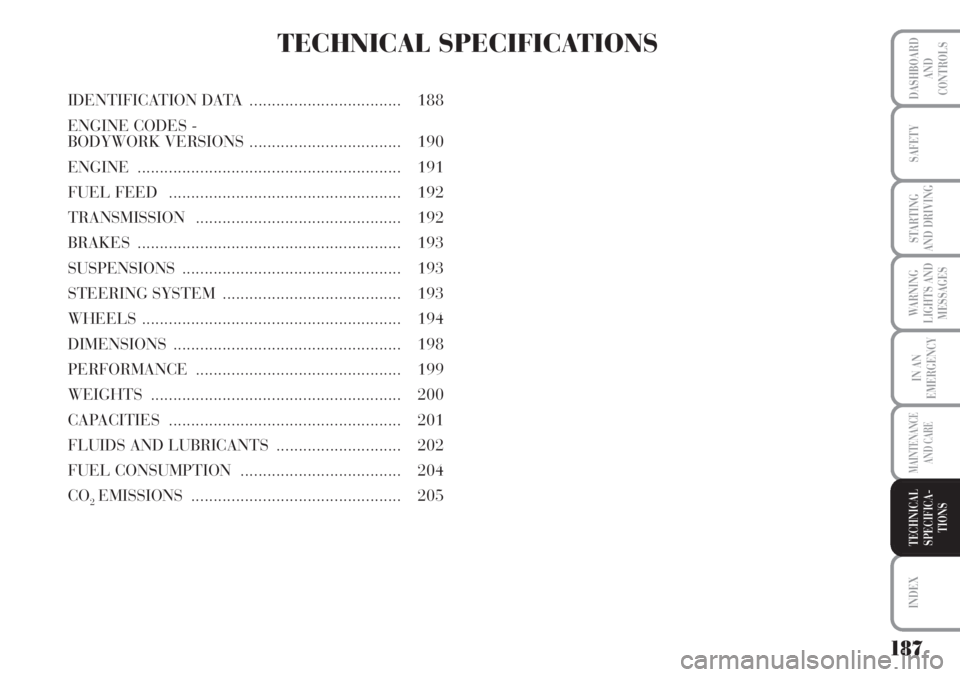
TECHNICAL SPECIFICATIONS
IDENTIFICATION DATA .................................. 188
ENGINE CODES -
BODYWORK VERSIONS.................................. 190
ENGINE........................................................... 191
FUEL FEED .................................................... 192
TRANSMISSION .............................................. 192
BRAKES........................................................... 193
SUSPENSIONS ................................................. 193
STEERING SYSTEM ........................................ 193
WHEELS .......................................................... 194
DIMENSIONS ................................................... 198
PERFORMANCE.............................................. 199
WEIGHTS........................................................ 200
CAPACITIES .................................................... 201
FLUIDS AND LUBRICANTS ............................ 202
FUEL CONSUMPTION.................................... 204
CO
2EMISSIONS ............................................... 205
187
WARNING
LIGHTS AND
MESSAGES
INDEX
DASHBOARD
AND
CONTROLS
SAFETY
STARTING
AND DRIVING
IN AN
EMERGENCY
MAINTENANCE
AND CARE
TECHNICAL
SPECIFICA-
TIONS
Page 189 of 218
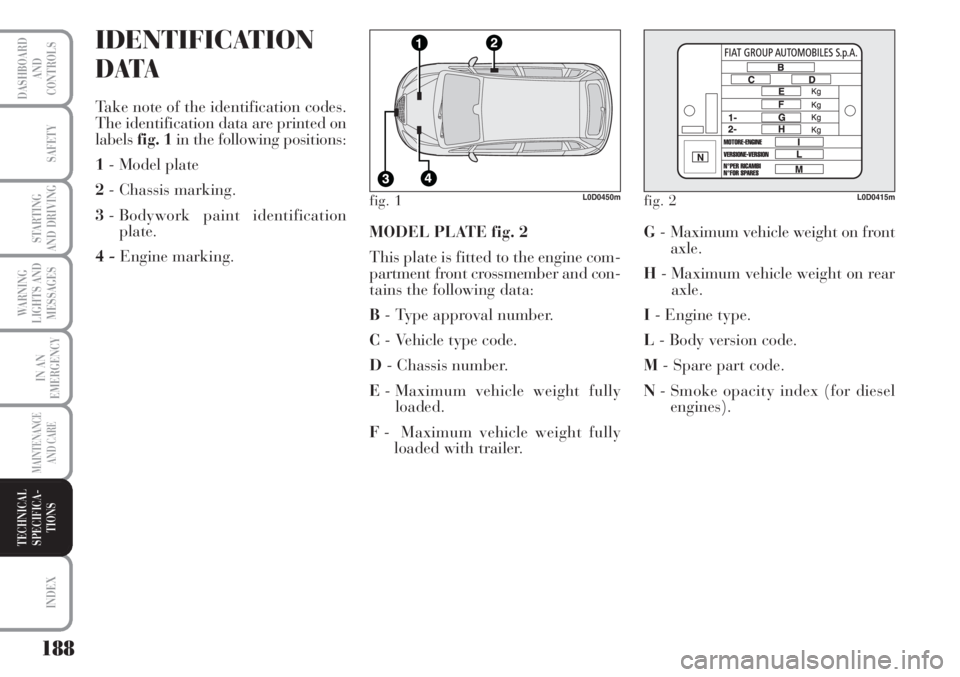
IDENTIFICATION
DATA
Take note of the identification codes.
The identification data are printed on
labelsfig. 1in the following positions:
1- Model plate
2- Chassis marking.
3- Bodywork paint identification
plate.
4 - Engine marking.MODEL PLATE fig. 2
This plate is fitted to the engine com-
partment front crossmember and con-
tains the following data:
B- Type approval number.
C- Vehicle type code.
D- Chassis number.
E- Maximum vehicle weight fully
loaded.
F- Maximum vehicle weight fully
loaded with trailer.G- Maximum vehicle weight on front
axle.
H- Maximum vehicle weight on rear
axle.
I- Engine type.
L- Body version code.
M- Spare part code.
N- Smoke opacity index (for diesel
engines).
fig. 1L0D0450mfig. 2L0D0415m
188
WARNING
LIGHTS AND
MESSAGES
INDEX
DASHBOARD
AND
CONTROLS
SAFETY
STARTING
AND DRIVING
IN AN
EMERGENCY
MAINTENANCE
AND CARE
TECHNICAL
SPECIFICA-
TIONS
Page 190 of 218

CHASSIS MARKING fig. 3
This is printed on the passenger com-
partment floor bed near the front
right seat.
The label can be accessed by lifting
the window in the mat and comprises:
❒vehicle model;
❒the chassis progressive number.
BODYWORK PAINT
IDENTIFICATION PLATE fig. 4
This plate is applied to the bonnet
and shows the following data:
A- Paint manufacturer.
B- Colour name.
C- Lancia colour code.
D- Respray and touch up code.ENGINE MARKING
It is stamped onto the cylinder block
(passenger compartment side) and
shows the type and the serial number.
fig. 3L0D0227m
fig. 4L0D0228m
189
WARNING
LIGHTS AND
MESSAGES
INDEX
DASHBOARD
AND
CONTROLS
SAFETY
STARTING
AND DRIVING
IN AN
EMERGENCY
MAINTENANCE
AND CARE
TECHNICAL
SPECIFICA-
TIONS